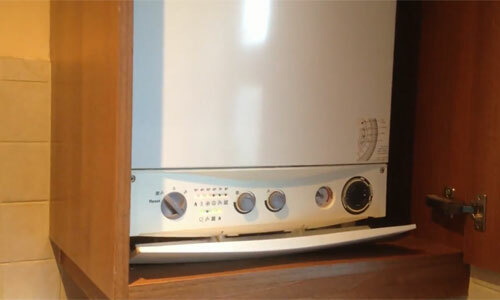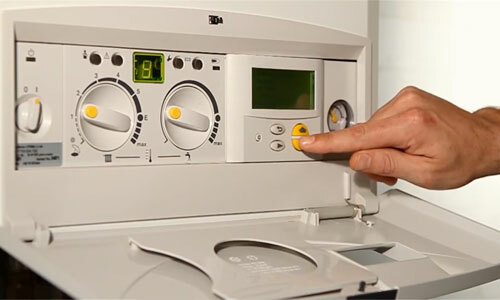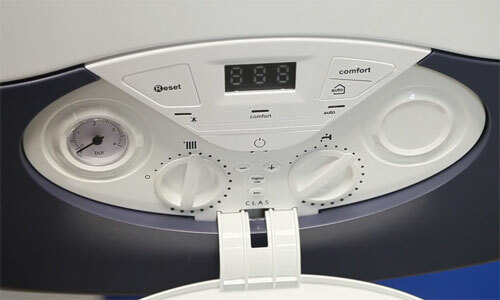Today, gas boilers are used not only in settlements where there is no centralized heating and hot water supply, but also in new homes within the city where it is available. The reason is clear: autonomous heating and hot water supply is the independence of housing services and the ability to maintain the air temperature in the apartment in accordance with their own ideas about comfort.

Before choosing a gas boiler, it is worth studying the information on the capabilities of modern models. We present to your attention a small guide that will help you navigate in the selection.
Step 1: Single-circuit and two-circuit systems
A gas heating boiler can have one or two circuits. In the first case, it heats water only for heating, in the second - for heating and hot water supply( DHW).Let's consider both variants in more detail.
Single-circuit boiler
The heating system based on a single-circuit boiler must be equipped with such additional elements:
- expansion tank;
- safety valve;
- circulating pump.
All of the above, together with the fittings, requires a lot of space and poorly fits in the design of the living quarters of the house, therefore single-walled boilers are often installed in separate rooms for special purposes. If the house is small and there is no room for the boiler room, you can buy a boiler with built-in fittings, a valve and a pump. Such models have a more stylish appearance and take up less space, so they can be installed in the kitchen.
Despite the absence of a second circuit, a single-circuit boiler can also be used to heat water in the DHW system. For this purpose, a tank( boiler) with a built-in heat exchanger is connected to the boiler circuit.
The advantage of such a DHW scheme is the possibility of servicing several water collection points.
The disadvantages are the complexity of installation and the relatively high cost of the boiler.
A single-circuit gas boiler with a boiler is a non-alternative option for a cottage with more than three people, as well as several bathrooms or kitchens. At the same time, hot water users do not need to be located near the boiler: the presence of a boiler makes it possible to circulate hot water in the DHW system, so whenever there is a hot water tap, it does not have to wait until the cold water is merged.
The volume of the boiler depends on the number of occupants and on the extent to which they consume water. Today, manufacturers offer storage capacity from 60 to 300 liters. Among the most popular are boilers with a volume of 100 to 160 liters. It is important that the capacity of the boiler corresponds to the volume of the boiler, otherwise the water in it will heat up too long.
Double-circuit boiler
Boilers with a two-circuit system do not require a storage tank, and therefore occupy much less space than their single-circuit "colleagues."In addition, such equipment is somewhat cheaper, and its installation requires less time and effort.
In addition to the above advantages, dual-circuit boilers have a significant drawback: they can not serve more than one point of water consumption at the same time. Therefore, most often such boilers are purchased for a small family house with one bathroom and kitchen, which are located next door. The farther the hot water tap from the double-circuit boiler is, the longer it takes to wait for cold water to drain from the DHW pipes.
Step 2: Wall or floor version?
Modern gas-fired boilers for a house in which one family lives, for the most part are made in a wall version. The floor installation is provided, as a rule, only for units of increased capacity or equipped with large volumes of tanks.
The wall-mounted boiler can be different from the floor and the heat exchanger material. If cast iron heat exchangers are installed in the floor unit, which are considered more reliable and reliable, the boilers are usually equipped with aluminum or steel heat exchangers, which have a lower weight.
Boilers with cast-iron heat exchangers are often used in homes with an old heating system, with which they are combined in the best way. In this case, the purchase of such a boiler is more expensive than equipment with an aluminum or steel heat exchanger.
Step 3: condensing or conventional?
Depending on the design, gas boilers are divided into conventional and condensing boilers. Which gas boiler is better? Definitely - condensation. Such a boiler allows you to assimilate more energy when burning gas fuel. Why is it more efficient?
The fact is that when fuel is burned, water vapor is formed, which simply "flies into the pipe" when the boiler is operating. As is known, when the aggregate state of a substance changes, a large amount of heat is released or absorbed. The design of the condensing boiler makes it possible to condense the water vapor generated by the combustion of the gas, thereby absorbing more energy.

The increase in the amount of heat obtained in this way is quite substantial: for natural gas it is 11%, for propane 9%.Therefore, the best boiler for the house is a condensing boiler. Its only drawback is a significant difference in price.
Step 4: manual or automatic control of
The operation of a modern gas boiler of any type provides for minimal human participation. After seasonal maintenance, stipulated by the standards( cleaning of the boiler and chimneys, checking the operability of all equipment), its start-up and adjustment, it works automatically throughout the season. But not all boilers work the same way. It all depends on what type of temperature controller is installed in this model. There are such types of temperature regulators:
Mechanical thermostat
The simplest and cheapest option. Supports the temperature of the coolant within the specified limits.

Programmable electronic thermostat
Corrects the operation of the boiler depending on the temperature in the room. Such a controller can be programmed, i.e.set different temperature parameters depending on the time of day or day of the week.
Weather thermostat with outside temperature sensor
The sensor of this controller monitors the temperature changes outside the house, in accordance with which the boiler operation is controlled. The application of this type of controller primarily optimizes the operation of inertial heating systems, such as floor heating. As a result, it is possible to raise the efficiency of the boiler.
Typically, the type of installed thermostat depends on the cost and class of the boiler: the usual boiler will most likely be equipped with a mechanical thermostat. However, if desired, the owner of an inexpensive boiler can purchase a full-featured expensive automation, which provides the following options:
- weather adjustment;
- programming of the temperature regime depending on the time of day and days of the week;
- independent regulation of individual circuits, etc.;
Step 5: selection of the manufacturer
The guarantee of long-term and full-fledged operation of the gas boiler is not only its quality, but also the possibility of professional service, as well as the availability of spare parts for sale. Therefore, before buying the unit, try to find out how well this manufacturer is represented in your region, and also how well the network of its authorized service centers is developed.
The choice in favor of a well-known brand will be a guarantee of safety. After all, the exploitation of poor-quality boiler equipment with defective automation can lead to severe consequences: poisoning of residents with gas or products of combustion, fire, and explosion.
If you do not have enough money to buy an expensive, modern condensing boiler with a full set of functions, it is better to buy a gas boiler of a conventional design and without bells and whistles, but a reliable manufacturer than a cheap Chinese machine with a complete "stuffing".
In conclusion, I would like to say a few words about buying a boiler for an apartment. Unfortunately, for your transition to independent heating your desire alone is not enough. In accordance with the law, the installation of gas equipment( boilers, continuous water heaters and gas boilers) is allowed only in those houses where chimneys are provided.
The withdrawal of combustion products through a conventional ventilation system is prohibited. So, if there is no chimney in your house, you will have to put up with centralized heating and hot water supply.
We wish you a successful purchase!
